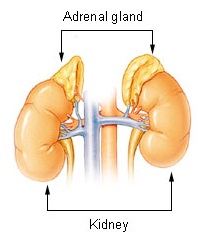Secondary adrenal insufficiency
| Adrenal insufficiency | |
 | |
|---|---|
| Adrenal gland |
|
Adrenal insufficiency Microchapters |
|
Diagnosis |
|---|
|
Treatment |
|
Case Studies |
|
Secondary adrenal insufficiency On the Web |
|
American Roentgen Ray Society Images of Secondary adrenal insufficiency |
|
Risk calculators and risk factors for Secondary adrenal insufficiency |
For patient information click here
Editor-In-Chief: C. Michael Gibson, M.S., M.D. [1]
Synonyms and keywords: hypocortisolism; hypocorticism; adrenocortical hypofunction
Overview
Historical Perspective
Primary adrenal insufficiency was first described in 1849 by Thomas Addison, demonstrating that the adrenal cortex is essential for life. On Thursday, March 15, 1849 almost a century ago, President John Hilton requested that, Dr. Addison, describe his latest medical findings before the South London Medical Society. These were Dr. Addison’s introductory comments, "A remarkable form of anemia, which, although incidentally noticed by various writers, had not attracted, as he thought, by any means the attention it really deserved…It was a state of general anemia incident to adult males, and had for several years past been with him a subject of earnest inquiry and of deep interest. It usually occurs between the ages of 20 and 60; sometimes proceeding to an extreme degree in a few weeks, but more frequently commencing insidiously, and proceeding very slowly, so as to occupy a period of several weeks, or even months, before any very serious alarm is taken either by the patient or by the patient's friends. Its approach is first indicated by a certain amount of languor and restlessness, to which presently succeed a manifest paleness of the countenance, loss of muscular strength, general relaxation or feebleness of the whole frame, and indisposition to, or incapacity for, bodily or mental exertion. These symptoms go on increasing with greater or less rapidity: the face, lips, conjunctive, and external surface of the body, become more and more bloodless; the tongue appears pale and flabby; the heart's action gets exceedingly enfeebled, with a weak, soft, unusually large, but always strikingly compressible pulse; the appetite may or may not be lost; the patient experiences a distressing and increasing sense of helplessness and faintness; the heart is excited, or rendered tumultuous in its action, the breathing painfully hurried by the slightest exertion, whilst the whole surface bears some resemblance to a bad wax figure: the patient is no longer able to rise from his bed; slight edema perhaps shows itself about the ankles; the feeling of faintness and weakness becomes extreme, and he dies either from sheer exhaustion, or death is preceded by signs of passive effusion or cerebral compression.” [1]
Classification
Three major types:
- Primary adrenal insufficiency
It is due to impairment of the adrenal glands. 80% are due to an autoimmune disease called Addison's disease or autoimmune adrenalitis. One subtype is called idiopathic, meaning of unknown cause. Other cases are due to congenital adrenal hyperplasia or an adenoma (tumor) of the adrenal gland.
- Secondary adrenal insufficiency
caused by impairment of the pituitary gland or hypothalamus.[2] Its principal causes include pituitary adenoma (which can suppress production of adrenocorticotropic hormone (ACTH) and lead to adrenal deficiency unless the endogenous hormones are replaced); and Sheehan's syndrome, which is associated with impairment of only the pituitary gland.
- Tertiary adrenal insufficiency
due to hypothalamic disease and a decrease in the release of corticotropin releasing hormone (CRH).[3] Causes can include brain tumors and sudden withdrawal from long-term exogenous steroid use (which is the most common cause).[4]
Pathophysiology
Causes
Differentiating Adrenal Insufficiency from other Diseases
Adrenal insufficiency can be difficult to diagnose in its initial stages. Medical history and symptoms is the cornerstone of diagnosis for the physician and confirmation through hormonal blood tests and urine tests further support preliminary diagnosis. The steps for the diagnosis of adrenal insufficiency allow the health care provider to distinguish between it and other diseases, therefore the steps of diagnosis are critical. Firstly, cortisol levels are determined followed by the establishment of the cause. In order to determine the cause imaging studies of the adrenal and pituitary glands are used. [2] [3] Adrenal insufficiency (Addison disease) may be difficult to differentiate from other conditions if the onset is gradual e.g. chronic fatigue syndrome and depression). [4][5] Physicians should consider in their differential diagnosis of adrenal insufficiency patients with suggestive symptoms, such as chronic fatigue, anorexia, nausea, vomiting, diarrhea, unexplained weight loss, dehydration, hypoglycemia, and hypotension. Physicians caring for patients with other known autoimmune disorders should consider these relevant diagnoses. Other conditions that must be considered include adrenocorticotropic hormone (ACTH) receptor defect, adrenoleukodystrophy and adrenomyeloneuropathy, autoimmune polyglandular endocrinopathy syndromes, infectious adrenalitis e.g. in association with human immunodeficiency [HIV] virus or tuberculosis (TB), adrenal hemorrhage, lipoid adrenal hyperplasia and Wolman disease. Antiphospholipid syndrome occasionally results in acute adrenal insufficiency secondary to bilateral adrenal hemorrhage. [6]
Differential Diagnoses:
• 3-Beta-Hydroxysteroid Dehydrogenase Deficiency • Adrenal Hypoplasia • Birth Trauma • Chronic Fatigue Syndrome (CFS) • Congenital Adrenal Hyperplasia • Familial Glucocorticoid Deficiency • Pediatric Hypopituitarism • Pseudohypoaldosteronism
Epidemiology and Demographics
Risk Factors
Natural History, Complications and Prognosis
Diagnosis
History and Symptoms | Physical Examination | Laboratory Findings | Electrocardiogram | Chest X Ray | CT | MRI | Ultrasound | Other Imaging Findings | Other Diagnostic Studies
Treatment
Medical Therapy | Surgery | Primary Prevention | Secondary Prevention | Cost-Effectiveness of Therapy | Future or Investigational Therapies
Case Studies
Related Chapters
- Addison disease, primary adrenocortical insufficiency
- ACTH stimulation test
- Cushing's syndrome, overproduction of cortisol
- Insulin tolerance test, another test used to identify sub-types of adrenal insufficiency.
- Adrenal fatigue (hypoadrenia), a term used in alternative medicine to describe a believed exhaustion of the adrenal glands.